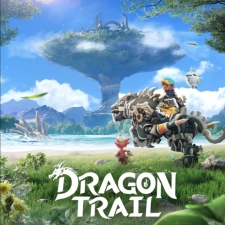This article was written by AppQuantum game designers Oleg Lomakov and Julia Kara.
The MMORPG genre is quite popular among PC games, but the mobile market has its hits too. New projects can compete with long-established giants. However, to attract a mobile audience, MMORPG games should take a closer look at casual gameplay.
AppQuantum's attention was drawn by the game Dragon Trail: Hunter World just over a week after the global release. During this time, the game earned enough to arouse our interest: the estimated revenue was more than $500,000.
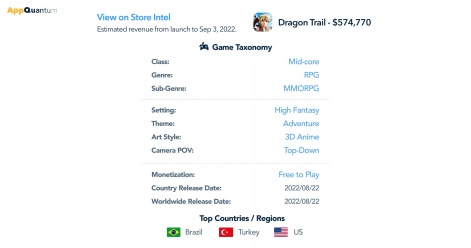
(And in the end, it turned out to be significantly bigger).
AppQuantum considered the news interesting because:
• This mobile game is MMORPG, the genre that we don’t usually focus on. So digging into the aspects of its success might result in us obtaining new and useful information.
• The game resembles one of the most popular cross-platform games — Monster Hunter. However, the two projects are not officially linked together.
• The game has already gained success in the eastern market. It’s time to evaluate its potential on a global level.
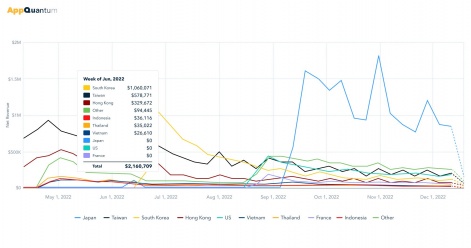
After a thorough study of Dragon Trail: Hunter World AppQuantum’s game designers Julia Kara and Oleg Lomakov found out what exactly had led the game to success. The research was carried out with the help of the Sensor Tower analytic system.
First things to be said:
The rapid growth of the downloads number right after the release, followed by their fast decline;
Net revenue remains high;
Considering all mentioned above, we may assume that the game is aimed at a long lifetime as well as payback at long-term retention.
Hypothesis
Each new project of the genre inevitably arouses interest. For how long will it be able to maintain good performance on the market? Making such an assumption is nearly impossible without having a clear idea of general market trends. This article looks at big MMORPG titles in retrospect and tries to identify the reasons behind their ups and downs. This will eventually lead us to the main point:
What exactly determines the success of a mobile MMORPG?
The research process was divided into several steps to make the structure of such a complex issue more clear:
If a game doesn’t belong to a big franchise already loved by its audience, are there any chances of it gaining a foothold in the market?
• Is the situation any different with single-player RPGs?
• Whether copying features from PC and console projects produce positive or negative effects on the game.
• Whether mobile MMOs need their own unique flow at all.
Statistics
Project’s performance
The highest number of downloads was achieved during the first week after the release, followed by a further stats decline. Though the players' influx rate can still reach its historical peak from time to time in ad campaigns.

The information taken from DAU (Daily Active Users) graph shows that the figure wasn't changing significantly during the first two weeks after the release date — about 130,000-150,000 players. Gaining such numbers exceptionally with new downloads (with a conditional lifetime of 1-2 days) would be impossible without the game being able to maintain long-term retention.
In other words, we may assume that Dragon Trail: Hunter World is rather addictive and that its earnings don’t depend on the influx of new users.
Around September 12, we saw another spike in activity. We thought that must have been connected with a recently released patch or an update, but apparently, the developers had simply launched a big ad campaign. Since then, the number of users has been slowly declining, and now it is slightly below the initial two-week plateau.
On the whole, the game failed to maintain its top rate, although the activity graph is still quite impressive.

At the same time, the game’s ARPDAU (Average Revenue per Daily Active User) has been gradually growing. Not only do players spend more time in the game, but they also generate income - which is extremely important for any MMORPG. Such games tend to count on a long-term Lifetime, so gaining a “long-term” audience is vital for them.
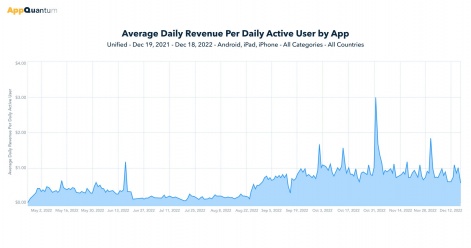
The overall income graph only confirms our assumptions. Despite the decline in downloads, the game continues to hold a fairly stable income. Though drawdowns are still noticeable from time to time, the situation, in general, seems viable.
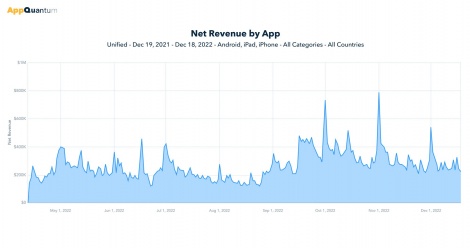
Mobile MMORPG market
Market situation
Take a look at the blue point on the graph below. This is Diablo: Immortal after its worldwide release. Impressive, isn't it?
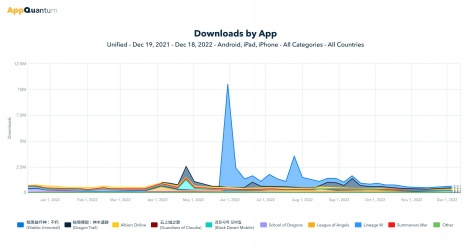
Let’s remove this game from the graph to get a better look at other projects. Here the competition becomes more visible, and we may notice that Dragon Trail declared itself as a potential competitor on the market.
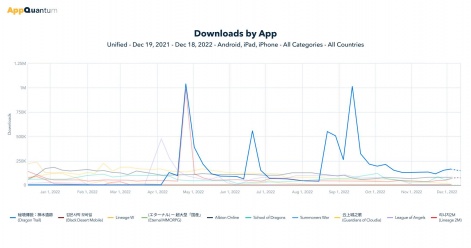
Other MMOs from this graph:
• Lineage2M
• School of Dragons
• Eternal MMORPG
• League of Angels: Chaos
• Summoners War
• Guardians of Cloudia
• Black Desert Mobile
• Albion Online
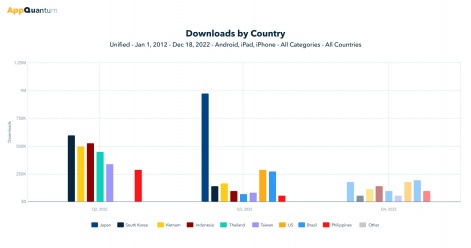
Now that we are done with the graph, let’s move on to the game itself.
Gameplay analysis
We will look at the main gameplay elements and features of Dragon Trail and compare them with other well-known games of the same genre. The collected information will then help us determine which changes are easily accepted by the players and which should rather be avoided.
Tutorial and first steps
Regarding retention, mobile games rely mainly on the player’s first experience and impression - at this stage, the player is shown the core gameplay along with the game’s main content.
Dragon Trail doesn’t have a “tutorial” in the proper sense of the word. Having created a character, the player finds themselves in the starting location with the first quest line. From the very start, the player can access the inventory, character panel, and equipment upgrades (though they get no hints on how to use any of that). The only help the player receives is an arrow that marks the quest panel.
AFK-Gameplay
The lack of a tutorial is compensated by the AFK gameplay (Away from Keyboard). Apart from starting the quest, all other actions required to complete the prologue are done automatically:
• A character moving from one quest point to another
• Activating dialogues
• Fighting
• Picking up loot and resources
• Opening windows and collecting rewards
On the one hand, this approach doesn't distract players from getting absorbed by the game as there is no need to look for necessary buttons all the time. On the other hand, it reduces the overall involvement in mechanics. Even though this may sound surprising, the casual audience doesn’t really care much.
All battles in Diablo: Immortal are controlled manually by the player. When completing quests, the character can automatically teleport to a certain location, but after that, the player gets full control of the process. However, the route to the current goal is always marked on the map, so it is nearly impossible to get lost. It all works well because Diablo is designed for a more mid-core audience than Dragon Trail.
Many projects offer the player a hybrid option: automatic running and battles, though they are not supposed to be the central mechanic for beating the game. Lineage W is an example of this approach. AFK buttons are integrated very smoothly into the main interface, and the player gets a tutorial on how to use them. However, the game doesn’t necessarily force you to do that.
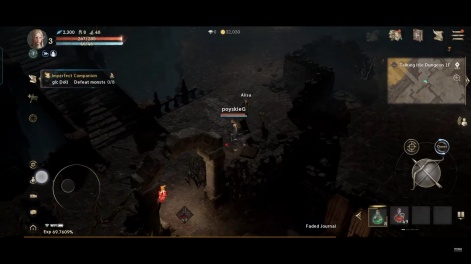
The main interface of Lineage W consists of 2 buttons: the main attack button and an auto attack button next to it. You always have it at hand though it doesn’t draw too much of your attention.
From the very beginning, Dragon Trail shows the player the main button - the quest window. When pressed, the character talks to the required character, defeats the required number of monsters, etc. The player can’t take control over the character at any time, though the tutorial cursor will continue pointing to a small window with a quest as if reminding about the main idea of the gameplay.
Turns out such gameplay is a great way of attracting and retaining players. Why?
These types of MMORPG supposedly provide an opportunity for the casual audience to get a more concentrated experience that resembles big PC titles like World of Warcraft or Lineage II. There is no need to spend time figuring out where to go and what to do: the character knows how to complete a mission in the shortest time possible. You won’t have to spend sleepless nights raiding and trying to get better — for every step you take, the game grants you level up’s and new equipment. After a few minutes of gameplay, the player encounters the first boss with an immense HP bar and then observes his character easily defeating a strong enemy. The basic attacks and several striking abilities that the game activates automatically make the battle look like a fantasy action film.
And yet the player never feels useless. Even if you usually put down your phone during battles, the game still requires your involvement when choosing a dialogue line or upgrading equipment. Furthermore, chests found along the way can only be picked up manually. All this keeps the game from turning into a movie. Finally, the quest window keeps its traditional form - a rectangle with some text at the edge of the screen, no catchy “allow me to play for you” buttons.
This way, the player gets the feeling of being in control of the overall process while taking advantage of the fact that they don’t have to be fully concentrated every single minute. Casual players are not usually prone to raiding, exploring dungeons, and choosing complex character builds.
Therefore, the user becomes both the author and the viewer of their own let's play content. And what is more, they get game experience which would be much harder to obtain otherwise.
Game modes
Various game modes are a common feature of classic RPG games. They are usually designed to keep players involved with changing dynamics of the gameplay: linear story missions switch to fast fights, with the latter then turning into high-level dungeons and cooperative raids.
Modes are not usually available right from the start. But over time, the player will eventually open each of them, gaining access to a wide range of content. This system is very well developed in Dragon Trail.
Having compared the activities mentioned here with other projects, we can single out some standard options:
• Island Voyage — Plays the role of the main story. Here the player makes their way through various locations, which end with boss fights.
• Mode — Main multiplayer. Here you can unlock single and co-op dungeons and a few PVP modes.
• Hunt boss and Drill — Single player with different difficulty settings, mainly to farm loot and XP. These are in fact, the same dungeons and arenas all RPG players are used to.
• Guild — Guild menu. Unlike the PVE and PVP modes, here, rewards are received mainly due to investments in the guild bank.
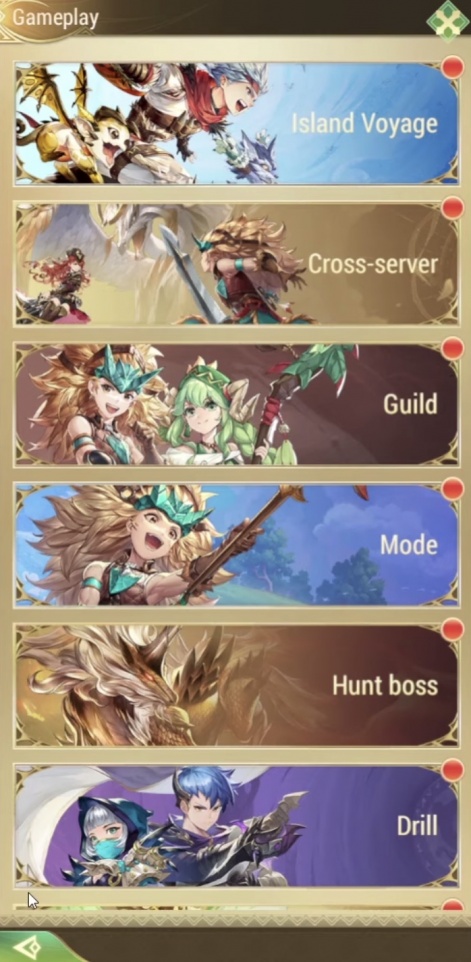
The differences here are mainly in the total number of mobs and their level, available loot, and locations. There are almost no unique mechanics, and most activities follow the “kill or be killed” rule.
Dragon Trail: Hunter World - Solo Mode, Team Mode & PVP Mode!
Upgrades
The main gameplay in Dragon Trail is based on classic RPG principles. The player controls the character of a certain class and selects and upgrades equipment while gradually unlocking new combat skills. You then proceed by completing standard questlines: talk to an NPC, unlock a location, kill mobs/bosses and collect loot.
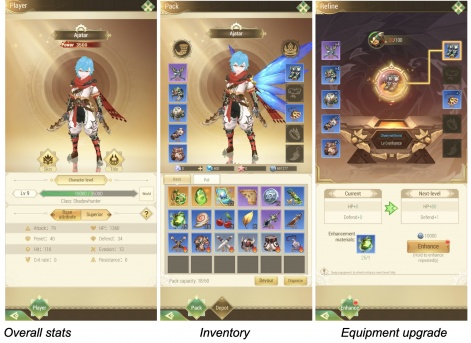
Pets
The pet system is probably the main feature of the game.
The mechanic itself is not a breakthrough, though Dragon Trail increases its importance significantly. Collecting and upgrading pets is now the key element to making your character stronger. You will need a well-prepared team in case you want to progress further without problems.
The pet system here is very close to the Pokemons we all know and love. Collect, feed and level up your pets so they can evolve into their better version.
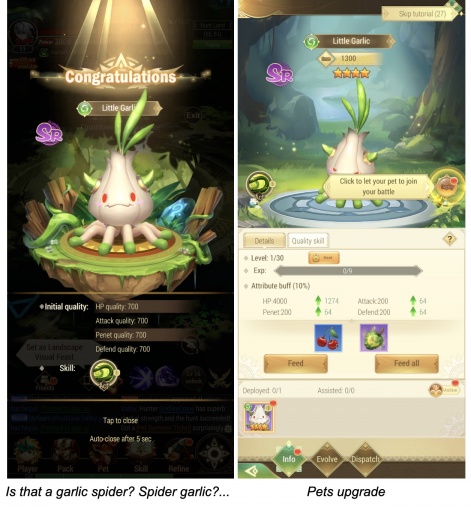
MMO-elements
From the very start, Dragon Trail positions itself as a classic MMO.
For example, in various story locations, you can run into other players occupied with their own affairs. After looking at them the thought will eventually pop up in your head: “I want to have the same cool equipment and pets as they do!”. This feeling is intensified even more by the global chat displaying in real time other players’ achievements: who has completed a dungeon, who has received a certain title, and so on.
However, a deeper analysis reveals that the multiplayer in Dragon Trail is much more reminiscent of a mobile game than it may seem at first.
Technically, the game offers only a few modes of the cooperative game, and you are reminded of other players only via leaderboards and guild notifications.
PVE
Co-PVE is available as a separate mode: a standard dungeon where the team must kill several waves of monsters and defeat the boss.
PVP
A team for a PvP battle consists of the player and their pets. The list of c opponents in the menu can help players estimate their strength.
Dragon Trail: Hunter World - Solo Mode, Team Mode & PVP Mode!
Monetization
The vast majority of mobile MMOs (and single-play as well) RPGs rely mostly on in-App monetization. Though ads can be found in such games, they are not seen as the main source of income.
Dragon Trail gets most of its revenue from in-game purchases. The store here is fairly simple: players buy resources, equipment, and treats for their pets.
Marketing
A large number of MMO-games that go global have a "start-up capital" of some sort which serves for attracting a larger audience. They can be roughly divided into two major sections:
Belonging to a franchise
Belonging to the Asian market
Statistics show that a WW release from the bottom up is too risky for projects with expensive development and a large reliance on online.
As far as Dragon Trail is concerned, the game combines both of the previously mentioned tactics.
Borrowing the setting and visuals from Monster Hunter the project looks like an attempt to occupy its niche on the mobile market. Considering that the full title of the game is Dragon Trail: Hunter World.
However, Monster Hunter is not a classical MMO. The game used to be single-player only, while its cooperative aspect (Monster Hunter: World) in terms of gameplay was more like an additional session.
In turn, Dragon Trail is closer to what we are used to seeing in classical Asian MMOs.
Here are some aspects that will make it more clear:
Monster Hunter: World
• The lobby is a single-player by default. Interaction with other players becomes possible only after the request to join their game.
• The social interface is hidden in a separate menu integrated into the game environment (message board, flares)
Dragon Trail
• Interaction with other players in the open world without restrictions
• The multiplayer aspect is always visible on the screen (global chat)
There are several reasons why this decision is particularly interesting:
Firstly, from a copy of a successful PC project, Dragon Trail has now turned into another variation and experimental combination of various MMORPG aspects.
Secondly, this is quite a bold move. Adapting the original Monster Hunter multiplayer system for mobile devices would seem rather simple: other hunters on your team could be easily replaced by pseudo-players in the asynchronous cooperative (bots that borrow other characters’ appearances).
Takeaways
• The long Lifetime of a project often means a large number of investments, expertise, and high labor costs. Like any other MMO which meets the requirements of the genre, Dragon Trail offers a huge well-developed world with a wide diversity of content. This way, the game’s income can be generated with a stable core audience.
• By launching an MMORPG with the AFK gameplay, developers should keep in mind that their project would hardly reach the heights of world popularity. Such games are common mostly in Asian countries.
• It might be worth taking risks trying to attract an audience by making your game similar to a popular title. Though you should also be prepared for failure - there are no guarantees.
• Perhaps one of the most important takeaways for us as a mobile game publisher is that there are endless opportunities to simplify the gameplay to attract a casual audience. The main thing is to offer an experience that will attract players.

